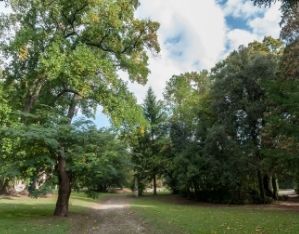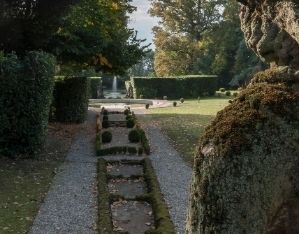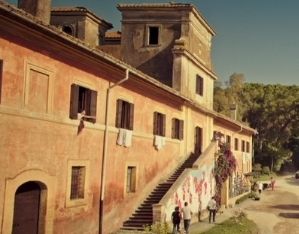 Warning
Warning
Due to the current health emergency situation, times and procedures may be subject to change. It is therefore advisable to check them by contacting the Villa directly.
An ensemble unique in its beauty, this park was built over a number of different periods, and combines very different styles and plant species.
The original complex, taken over in 1599 by the Cenami family, was acquired by the Mansi family in 1675. Between 1725 and 1732, Ottavio Mansi (most likely) commissioned Filippo Juvarra to transform the garden with a system of locks and waterworks. All that remains today of these 18th-century works is the cascading water feature that runs through the park longitudinally, ending in an octagonal basin that, in Juvarra’s design, stood at the centre of a small wood with radial avenues. From here, the water flows on into a large, elegantly-designed fishpond decorated with balustrades and statues. Next to the pool, towards the villa, there used to be a walled, hidden secret garden for growing flowers within geometric
Highlights

The Villa
Built in the latter half of the 16th century, the original building was significantly transformed in 1634-1635 by architect Muzio Oddi. It was subsequently renovated by the Mansi family, to a design by Lucca-born architect Giovan Francesco Giusti. With its sequence of serliana windows, the elevation is likened to a theatrical frons scaenae.

Woodland
A romantic expanse of woodland runs around the meadow, featuring monumental specimens of exotic species (Cedrus atlantica, Picea abies, Pseudotsuga menziesii, Chamaecyparis lawsoniana, and Liriodendron tulipifera).

The Octagonal Basin
With its small waterfalls and water features, canals are a recurring element in these Lucca gardens. At Villa Mansi, a cascade of water crosses the park longitudinally, flanked by hedges and statues of human and animal figures. The small waterfall ends in the large octagonal basin that was the centrepiece of Juvarra’s design.

The Stables as a Film Set
Several scenes for Paolo Virzì’s film Like Crazy were shot in 2016 in the beautiful stables here, two long buildings to the east of the villa which form a triangular courtyard enclosed by a 19th-century-style arcade.
 Villa Mansi
Contacts
Villa Mansi
Contacts
 Villa Mansi
Opening times and prices
Villa Mansi
Opening times and prices
Opening hours
The Park and the Villa are open from Monday to Friday from 14.00 to 18.00. Closed on Saturdays and Sundays.
Pricing
- Adults € 7,00
- Groups from 1 to 9 people € 7,00
- Groups from 10 to 29 people € 6,00
- Groups over 30 people € 5,00
- Free for children up to 10 years old and group leaders.
 Villa Mansi
How to get there
Villa Mansi
How to get there
Address
Via delle Selvette, 259
55012, Capannori (LU)
Latitude: 43.8999917
Longitude: 10.6186046
How to arrive by road
From Lucca
Leave the A11 motorway at LUCCA EST and follow the signs for the CENTRE. You will be on viale Europa and after passing the overpass you will see the Walls in front of you. Keep right and take the ring road towards east. Take the state road n° 435 -viale Castracani- known as “la Pesciatina” and follow the signs for PISTOIA-PESCIA. After about 6 km from Lucca you will arrive in ZONE. At the traffic lights turn left where you will see blue signs for SEGROMIGNO MONTE or yellow signs for VILLA MANSI. Continue on the main road (always straight ahead) until you see the boundary wall of the Villa Mansi in front of you.
From Capannori
Leave the A11 motorway at the Capannori exit and turn left following signs for CAPANNORI/PORCARI. Pass the railway and after 1.8 km you will find a roundabout, follow for PORCARI/BAGNI DI LUCCA on the right. After 500 mt you will find a second roundabout where you will see the ESSELUNGA supermarket on your right. Enter the roundabout and take the third road following signs for PESCIA/BAGNI DI LUCCA. Continue on this road for 2.4 km. You will see a white road sign LUNATA. After 200 meters from the sign you will meet the main road VIA PESCIATINA. Turn right towards PESCIA and after 600 meters you will find a traffic light with blue signs SEGROMIGNO MONTE and yellow signs for VILLA MANSI.
How to arrive by train
From the stations of Florence or Pisa you can take a regional train to Lucca. From Florence it takes about 1h and 20 minutes and trains are every hour. From Pisa it takes about 25 minutes and trains are every hour. Once you arrive at Lucca station it is advisable to take a taxi as the area is not served by public transport.
Additional directions
The nearest airports are Pisa and Florence. From Florence airport if you rent a car you can follow the instructions in point 1 for those arriving by car, otherwise you can reach the city centre of Lucca by bus (VAIBUS line). These buses also stop at Lucca Station, where you can then take a taxi to the Villa.
 Villa Mansi
Services/Accessibility
Villa Mansi
Services/Accessibility
Accessibility
The visit is limited to the Park where there are no architectural barriers.
 Villa Mansi
Private events
Villa Mansi
Private events
 Villa Mansi
Itineraries
Villa Mansi
Itineraries
You could find the garden in these itineraries
 Favorite saving result
Favorite saving result
 Warning!
Warning!
You've have to sign up or sign in to add this element to your favorites.
